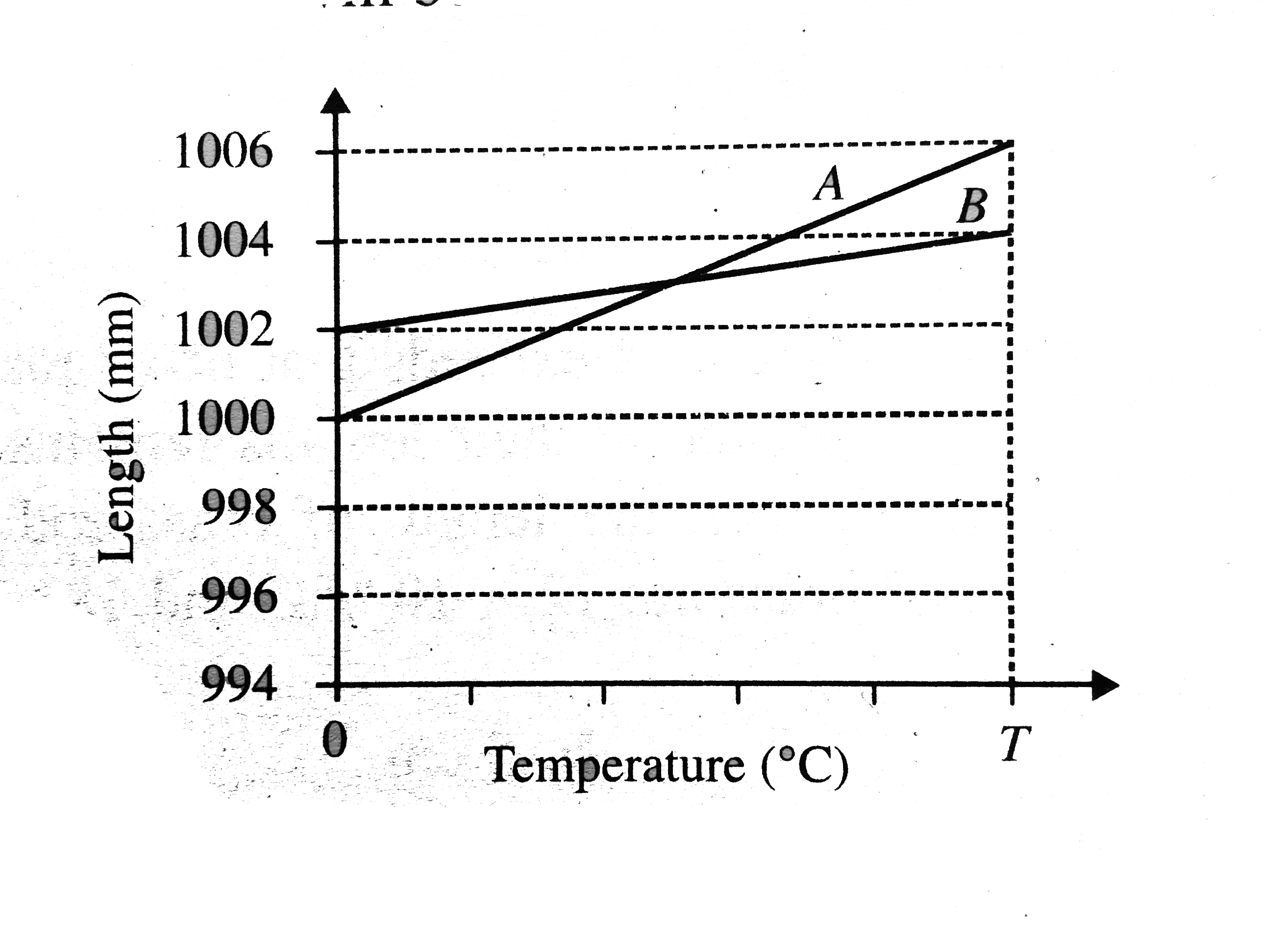The volume of a block of a metal changes by 0.12% when it is heated through 20∘C . The coefficient of linear expansion of the metal is
4×10−5∘C−1
2×10−5∘C−1
0.5×10−5∘C−1
4×10−4∘C−1
The correct Answer is:B
To find the coefficient of linear expansion (α) of the metal given that the volume changes by 0.12% when heated through 20°C, we can follow these steps:
Step 1: Understand the relationship between volume change and linear expansion
The change in volume (ΔV) of a material when it is heated can be expressed in terms of the coefficient of volume expansion (γ) and the change in temperature (Δθ):
ΔVV=γΔθ
Where:
- ΔV is the change in volume,
- V is the original volume,
- γ is the coefficient of volume expansion,
- Δθ is the change in temperature.
Step 2: Relate the coefficient of volume expansion to the coefficient of linear expansion
The coefficient of volume expansion (γ) is related to the coefficient of linear expansion (α) by the formula:
γ=3α
Step 3: Substitute the known values into the equation
We know that the volume change is 0.12%, which can be expressed as:
ΔVV=0.12100=0.0012
The change in temperature is given as:
Δθ=20°C
Now, substituting these values into the volume change equation:
0.0012=γ×20
Step 4: Substitute γ in terms of α
Using the relationship between γ and α:
0.0012=(3α)×20
Step 5: Solve for α
Rearranging the equation gives:
0.0012=60α
Now, solving for α:
α=0.001260
α=0.00002
Step 6: Convert to scientific notation
Converting 0.00002 to scientific notation gives:
α=2×10−5 per degree Celsius
Final Answer
The coefficient of linear expansion (α) of the metal is:
α=2×10−5 per degree Celsius
---
The change in volume (ΔV) of a material when it is heated can be expressed in terms of the coefficient of volume expansion (γ) and the change in temperature (Δθ):
ΔVV=γΔθ
Where:
- ΔV is the change in volume,
- V is the original volume,
- γ is the coefficient of volume expansion,
- Δθ is the change in temperature.
The coefficient of volume expansion (γ) is related to the coefficient of linear expansion (α) by the formula:
γ=3α
We know that the volume change is 0.12%, which can be expressed as:
ΔVV=0.12100=0.0012
The change in temperature is given as:
Δθ=20°C
0.0012=γ×20
Using the relationship between γ and α:
0.0012=(3α)×20
Rearranging the equation gives:
0.0012=60α
Now, solving for α:
α=0.001260
α=0.00002
Converting 0.00002 to scientific notation gives:
α=2×10−5 per degree Celsius
The coefficient of linear expansion (α) of the metal is:
α=2×10−5 per degree Celsius
Topper's Solved these Questions
- BOOK - NCERT FINGERTPS ENGLISHCHAPTER - THERMAL PROPERTIES OF MATTEREXERCISE - Specific Heat5videos
THERMAL PROPERTIES OF MATTER
- BOOK - NCERT FINGERTPS ENGLISHCHAPTER - THERMAL PROPERTIES OF MATTEREXERCISE - Calorimetery4videos
THERMAL PROPERTIES OF MATTER
- BOOK - NCERT FINGERTPS ENGLISHCHAPTER - THERMAL PROPERTIES OF MATTEREXERCISE - Measurement of Temperature2videos
THERMAL PROPERTIES OF MATTER
- BOOK - NCERT FINGERTPS ENGLISHCHAPTER - SYSTEM OF PARTICLES AND ROTATIONAL MOTIONSEXERCISE - NCERT Exemplar8videos
SYSTEM OF PARTICLES AND ROTATIONAL MOTIONS
- BOOK - NCERT FINGERTPS ENGLISHCHAPTER - THERMODYNAMICSEXERCISE - Assertion And Reason15videos
THERMODYNAMICS
Similar Questions
The volume of a solid decreases by 0.6% when it is cooled through 50∘C. Its coefficient of linear expansion is
View SolutionA uniform metal rod of 2mm2 area of cross section is heated from 0∘C to 20∘C. The coefficient of linear expansion of the rod is 12×10−6/∘C. Its Young's modulus of elasticity is 1011N/m2, then the energy stored per unit volume of rod is,
View Solution
Knowledge Check
- Question 1 - Select One
The volume of a metal sphere increases by 0.24% when its temperature is raised by 40∘C . The coefficient of linear expansion of the metal is .......... .∘C
A2×105.∘C−1B6×10−5.∘C−1C18×10−5.∘C−1D1.2×10−5.∘C−1
The volume occupied by a thin- wall brass vessel and the volume of a solid brass sphere are the same and equal to 1,000cm3at0∘C. How much will the volume of the vessel and that of the sphere change upon heating to 20∘C? The coefficieny of linear expansion of brass is α=1.9×10−5.
View SolutionA clock with a metallic pendulum gains 6 seconds each day when the temperature is 20∘C and loses 6 second when the temperature is 40∘C. Find the coefficient of linear expansions of the metal.
View Solution
The variation of length of two metal rods A and B with change in temperature is shown in Fig. the coefficient of linear expansion αA for the metal A and the temperature T will beView Solution
The variation of length of two metal rods A and B with change in temperature is shown in Fig. the coefficient of linear expansion αA for the metal A and the temperature T will be? ( alpha_(A)=3x10^(-6)/ C )View SolutionA uniform metal rod is used as a bar pendulum. If the room temperature rises by 10∘C, and the coefficient of linear expansion of the metal of the rod is 2×10−6per∘C, the period of the pendulum will have percentage increase of
View SolutionA uniform metal rod is used as a bar pendulum. If the room temperature rises by 10∘C, and the coefficient of linear expansion of the metal of the rod is 2×10−6per∘C, the period of the pendulum will have percentage increase of
View SolutionA uniform metal rod is used as a bar pendulum. If the room temperature rises by 10∘C, and the coefficient of linear expansion of the metal of the rod is 2×10−6per∘C, the period of the pendulum will have percentage increase of
View Solution

